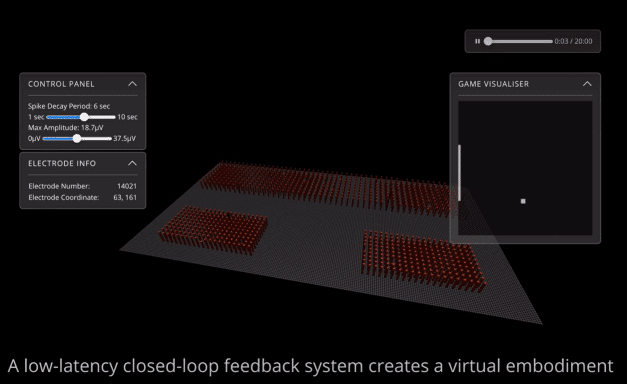The research team took mouse cells from embryonic brains as well as some human brain cells derived from stem cells and grew them on top of microelectrode arrays that could both stimulate them and read their activity.
They connected this mini-brain (dubbed as Dishbrain) to the video game via electrodes. Electrodes on the left or right of one array were fired to tell Dishbrain which side the ball was on, while distance from the paddle was indicated by the frequency of signals. Feedback from the electrodes taught DishBrain how to return the ball, by making the cells act as if they themselves were the paddle.
In response, the cells produced electrical activity of their own. They expended less energy as the game continued.

But when the ball passed a paddle and the game restarted with the ball at a random point, they expended more recalibrating to a new unpredictable situation. The mini-brain learned to play in five minutes.
It often missed the ball – but its success rate was well above random chance.
Although, with no consciousness, it does not know it is playing Pong in the way a human player would, the researchers stress.
“We’ve never before been able to see how the cells act in a virtual environment,” Kagan says, “In the past, models of the brain have been developed according to how computer scientists think the brain might work,… that is usually based on our current understanding of information technology, such as silicon computing.
“But in truth we don’t really understand how the brain works.”
By building a living model brain from basic structures in this way, scientists and researchers will be able to experiment using real brain function rather than flawed analogous models like a computer.
Kagan and his team will next experiment to see what effect alcohol has when introduced to DishBrain.
“We’re trying to create a dose response curve with ethanol – basically get them ‘drunk’ and see if they play the game more poorly, just as when people drink,” says Kagan.
That potentially opens the door for completely new ways of understanding what is happening with the brain.
The findings also raise the possibility of creating an alternative to animal testing when investigating how new drugs or gene therapies respond in these dynamic environments.
“We have also shown we can modify the stimulation based on how the cells change their behaviour and do that in a closed-loop in real time,” says Kagan.
Dr Hon Weng Chong, Chief Executive Officer of Cortical Labs, says he was excited by the discovery, but it was just the beginning.
“This is brand new, virgin territory. And we want more people to come on board and collaborate with this, to use the system that we’ve built to further explore this new area of science,” he says.
“As one of our collaborators said, it’s not every day that you wake up and you can create a new field of science.”
Taken from scienceinpublic.com.au
Limited free articles. Subscribe for full access.








 Dr. Bilal Philips
Dr. Bilal Philips